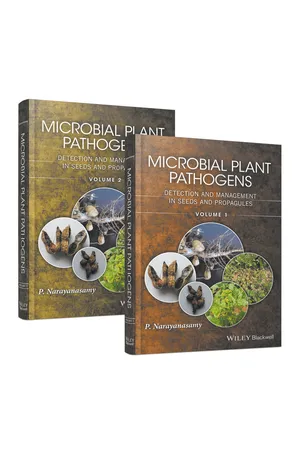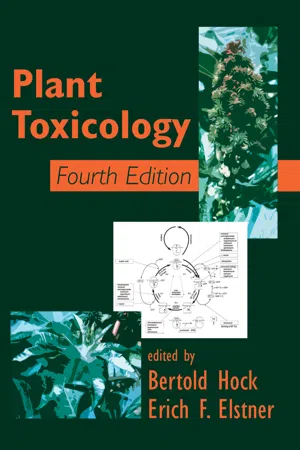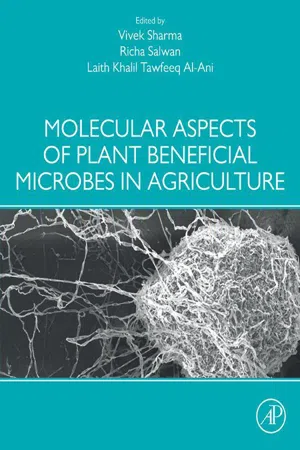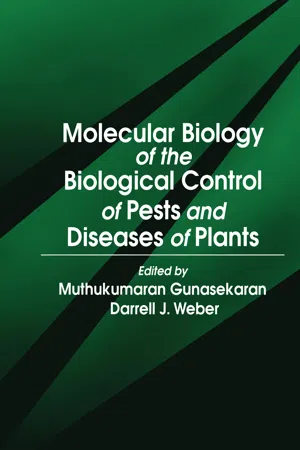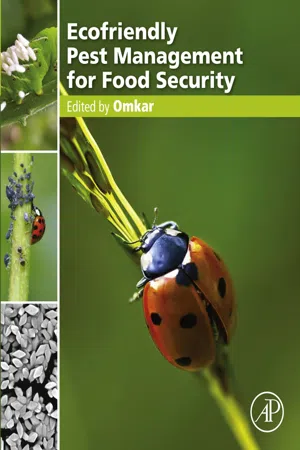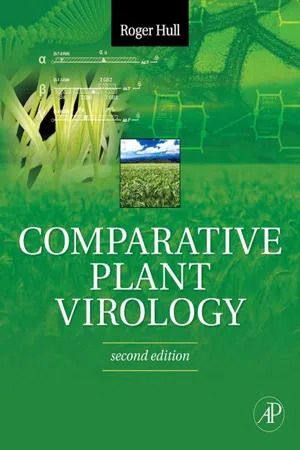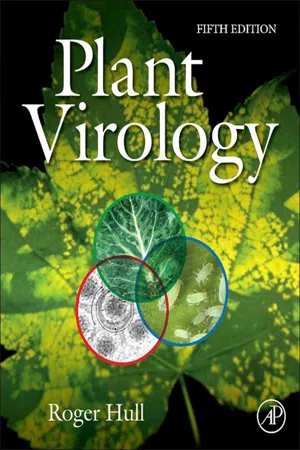Biological Sciences
Plant Viruses
Plant viruses are infectious agents that specifically infect plants, causing diseases that can lead to reduced crop yields and economic losses. They consist of genetic material surrounded by a protein coat and can be transmitted through various means such as insect vectors, contaminated tools, and infected seeds. Plant viruses pose a significant threat to agriculture and food security worldwide.
Written by Perlego with AI-assistance
Related key terms
Related key terms
1 of 4
Related key terms
1 of 3
11 Key excerpts on "Plant Viruses"
- eBook - ePub
Microbial Plant Pathogens
Detection and Management in Seeds and Propagules
- Perumal Narayanasamy(Author)
- 2016(Publication Date)
- Wiley(Publisher)
Viruses are ultramicroscopic and intracellular obligate pathogens, capable of infecting all living organisms from primitive prokaryotes to highly evolved human beings. Although infection of tulips resulting in tulip break disease was known of for a long time, it was not until the late nineteenth century that viruses were proven to be the causative agents of plant diseases. As viruses are obligate pathogens, requiring the presence of living cells for their existence, their presence in the plants and vectors involved in their transmission from infected plants to healthy plants has to be detected at the earliest possible time by employing sensitive, specific, rapid, and reliable techniques to identify the sources of inoculum. The management of plant virus diseases is largely limited to preventive methods by eliminating infected seeds and propagules and establishing virus‐free seed stocks. If seeds and planting materials are not assessed for virus infection they may ruin crops within a short period of time due to the rapid increase in infection levels through subsequent generations. It is imperative to monitor the movement of seeds and planting materials, as globalization facilitates unrestricted exchange of seed materials between countries and regions in a country. Knowledge of various factors that influence virus infection and the development of disease in individual plants, and the spread of disease in individual plants and in plant populations, is required to develop short‐ and long‐term strategies to restrict disease incidence and subsequent spread in the field. Furthermore, the biology of viruses has to be studied to understand their pathogenic potential (virulence), genetic variability, host range, virus–vector relationship, and their survival in the absence of primary host (crop) plant species in order to target the weak link in the disease cycle for the eradication of the virus disease(s).8.1 Characteristics of Plant Viruses
Plant Viruses have simple morphological characteristics with limited variations in the particle morphology that are useful for their reliable identification and differentiation. All viruses have a protein coat (covering) to protect viral genomic nucleic acid from inactivation. The viral nucleic acid may be of either ribonucleic acid (RNA), as in the majority of Plant Viruses, or deoxyribonucleic acid (DNA) molecules. The viral genome may be encapsidated either in one type of particle (monopartite) or in two (bipartite) or more types of particles (multipartite). There is no evidence for the production of any virus‐specific enzyme present in the virus particle or in their capacity for producing any enzyme of their own during the infection process (pathogenesis). They have to depend entirely on the synthetic machinery of the susceptible host plant for their replication, leading to the development of various types of external and internal symptoms depending on the virus–host interactions. The virus replication process is distinct from other cellular pathogens. Viruses represent particulate entities which are similar to cellular constituents and do not possess any organelle of cellular organisms. The viral components – coat protein (CP) and genomic nucleic acid – are synthesized separately in different sites in susceptible host cells. Viral genomic nucleic acids carry the required information for synthesizing viral components, taking command of the host’s synthetic systems and directing the synthesis of the required amino acids and nucleotides for viral coat protein and genomic nucleic acid. When the viral coat protein and nucleic acid reach required the concentrations, they are assembled to form infective mature virions (Narayanasamy 2011). The nature of viral genomic nucleic acid, particle morphology, presence of membranous envelope, immunological properties, nucleotide sequences of genomic nucleic acid and amino acid sequences of viral coat (capsid) protein, and the presence of virus‐associated protein are the major characteristics used for the identification, classification, and differentiation of Plant Viruses and their strains (Chapter 7 - eBook - ePub
- Bertold Hock, Erich F. Elstner(Authors)
- 2004(Publication Date)
- CRC Press(Publisher)
10 Host–Pathogen Relations: Diseases Caused by Viruses, Subviral Organisms, and Phytoplasmas Balázs Barna and Ló ránt Kirá ly Plant Protection Institute, Hungarian Academy of Sciences, Budapest, Hungary In this chapter the biochemical and physiological events leading to damage and disease symptoms in virus-infected plants are briefly summarized. Naturally, this summary is by far not complete. Although virus diseases of plants have been known a long time, discovery of Plant Viruses and plant virology itself are only about 100 years old. As an introduction we have to summarize some definitions and terms. I. VIRUSES Viruses are submicroscopic, infectious nucleoproteins, obligate intracellular parasites. The most important features of viruses are as follows: Virus particles are produced from the assembly of preformed components. Virus particles (virions) themselves do not grow or undergo division. Viruses lack the genetic information for the generation of metabolic energy or for protein synthesis (no metabolism). Viruses have only either infectious ribonucleic acid (RNA) or deoxyribonucleic acid (DNA). Until recently, one of the basic tenets was that Plant Viruses, unlike bacterial and animal viruses, did not integrate into host genomes. Data over the past few years have broken this tenet, and now an increasing number of integrated plant viral sequences are being found in plant genomes (1). The damage caused by virus infection is manifested on plants by various symptoms. In the case of compatible interaction that generally means systemic spread of the virus without cellular disruption. On the other hand, infection of plants by viruses results in reduction of plant size and yield. Since most plant virus infections are not accompanied by clear damage (in contrast to infection by animal viruses), the resulting yield reduction remains an enigma - eBook - ePub
Viruses
Molecular Biology, Host Interactions, and Applications to Biotechnology
- Paula Tennant, Gustavo Fermin, Jerome E. Foster(Authors)
- 2018(Publication Date)
- Academic Press(Publisher)
Chapter 6Viruses as Pathogens
Plant Viruses
Paula Tennant1 , Augustine Gubba2 , Marcia Roye1 and Gustavo Fermin3 ,1 The University of the West Indies, Mona, Jamaica,2 University of KwaZulu-Natal, Pietermaritzburg, South Africa,3 Universidad de Los Andes, Mérida, VenezuelaSummary
Viruses, as they replicate in the plant host, can disrupt cellular processes and host physiology to cause disease. The range in disease reactions, from yellowing to dwarfing and reduction in host fecundity, culminates in sizable losses along with decreases in the aesthetic value in commercial cultivations, landscape plants, or home gardens. Typically, these reactions occur in plants that have not developed specific defensive responses against virulence factors produced by the virus. However, there can be instances where plants, in both natural and cultivated populations, carry inherent disease resistance but are not protected against virus infections. Successful disease management strategies are therefore aimed at the prevention or the reduction of virus infections and require an understanding of how viruses survive and spread between crops and across seasons. Since different diseases have distinct ecological and epidemiological characteristics, there is no “one-size-fits-all ” approach to management. Diseases caused by Plant Viruses affecting cassava, sweet potato, banana, corn, rice, wheat, and various vegetable crops are examined in this chapter.Keywords
Geminiviruses; potyviruses; criniviruses; babuviruses; cucumoviruses; tungroviruses; waikaviruses[Regarding Plant Viruses] It is likely that the interaction between the host defense system and the viral defense suppression system is the major determinant of both host range and symptom expression.Roger HullIn just over one hundred years since the description of the first plant virus, the number of plant virus species has seemingly increased exponentially. Indeed, more than 1000 virus species are presently known to infect cultivated field, vegetable, and fruit crops worldwide. The exponential increase is attributed not only to the discovery of new viruses, but also to the improved diagnostic testing and the correction of cases where virus infections were mistaken for other conditions. Increased international movement and globalization of trade have also influenced the introduction and proliferation of viruses across countries. - Vivek Sharma, Richa Salwan, Laith Khalil Tawfeeq Al-Ani(Authors)
- 2020(Publication Date)
- Academic Press(Publisher)
Roossinck et al., 2010 ). Sequencing results showed that 70% of samples showed presence of viruses, however the level of homology is not very high just enough to estimate their family. These two studies clearly showed that our knowledge about viral population is very limited.With growing interest in viruses, we started understanding their biology. Eventually the information comes in both ways i.e. in terms of host and pathogens and it opens newer era of biology (like pathogenicity, interaction within host, host immune response, genetic engineering, etc.). In this chapter, we are focusing on some of those outcomes, which have been utilized in agronomy or to understand plant biology. When we follow historical achievements, there are many reports of “cross protection” or “vaccination” in past, in which milder strain of virus is used for providing protection against severe strains. All these viral strains naturally exist in host species and were successfully used to control loss caused by severe strains. This phenomenon further led to genetic engineering of plants to provide resistance against harmful viruses. Viruses are known to alter plant biology in many ways and some of these changes had beneficial effects on hosts. Similarly, there are well known group of viruses mainly Partitiviruses which do not cause any noticeable disease or loss in crops. With advancement in technology and refinement in knowledge now newer perspective of these viruses starts appearing which can be utilized for benefit of mankind. Beneficial aspect of viruses is a new emerging area of plant virology and limited information is available on it. In this chapter, we are trying to shed light on some of the useful aspects of viruses which are or can be utilized in agriculture.14.2 Virus infection improves host tolerance to various stresses
Being sessile in nature, plants face a number of biotic and abiotic stresses in field conditions. High temperature and soil water deficit (WD) are the major abiotic stress causing changes in host growth and productivity (Zhang and Sonnewald, 2017 ). Virus-plant being in mutualistic association, changes the adverse effect in different ways by communicating and signaling host defense. To study the effect of viral infection during WD conditions, Bergès et al., 2018 infected nine wild accessions of Arabidopsis thaliana (L.) Heynh (Brassicaceae ) showing differential responses in WD conditions, with Cauliflower mosaic virus (CaMV; Caulimoviridae- eBook - ePub
- Christon J. Hurst(Author)
- 2000(Publication Date)
- Academic Press(Publisher)
Bemisia tabaci. The ability of the virus to spread and reach epidemic proportions depends on several ecological factors that directly or indirectly influence the population dynamics of the aerial vectors, its feeding behavior, or its movement over long distances, and certainly the availability of susceptible cultivated or wild hosts. In the light of these ecological factors, management strategies to prevent virus infections are discussed. Finally, the role of man by manipulating the agroclimatic environment and indiscriminate movement of plant material is highlighted, which, in some instances, has led to the emergence of new recombinant viruses.I. INTRODUCTION
Viruses are infectious nucleoproteins that must have a living cell to multiply in and establish themselves. All viruses are obligate parasites containing either an RNA or DNA genome enveloped in a protective protein coat. Approximately one-fourth of all the known viruses cause diseases in plants. A plant virus may infect a variety of plants, thus having a broad host range, or may be restricted to a single species of plant.Plant Viruses occur in different sizes and shapes but can be broadly categorized as rods (rigid or flexuous), or spherical (isometric or polyhedral), or bacilliform, that is, bullet shaped. Some elongated viruses are rigid rods about 15 ×300 nm, but most are long flexible threads 10–13 nm wide and 480–2000 nm in length. Most spherical viruses are actually icosahedral, about 13–60 nm in diameter. The virus particles consist of a definite number of protein subunits that package the nucleic acid genome and are spirally arranged in elongated viruses and packed along the sides in polyhedral viruses. Some viruses also have an outer lipoprotein envelope surrounding the coat protein.Each plant virus particle consists of at least one molecule of a nucleic acid and a protein shell. The nucleic acid of most Plant Viruses consists of RNA, but some are also known to have DNA, which may be single or double stranded. The nucleic acid makes up 5–40% of the virus mass, and the protein makes up the remaining 60–95%. The genome of many Plant Viruses are split into two or more nucleic acid components, each of which may be individually encapsidated. The coat protein of the virus not only provides protection for the nucleic acid but also plays a role in vector transmission of the virus, the kind of symptoms it causes, and its movement in the plant. Most of the proteins encoded by Plant Viruses, therefore, have special functions either in vector transmission, movement in the plant, in cleavage of the viral polyproteins, or to produce inclusion bodies in the cells. - Muthukumaran Gunasekaran, Darrell Jack Weber(Authors)
- 2020(Publication Date)
- CRC Press(Publisher)
2Molecular Approaches to Biological Control of Virus Diseases of Plants
Rebecca Grumet and Tatiana Lanina-ZlatkinaTABLE OF CONTENTS
I. Introduction II. Viral Parasites A. Viral Satellites B. Defective Interfering Particles (Dis) III. Pathogen-Derived Resistance A. Coat Protein Genes B. Replicase Genes C. Movement Protein and Protease Genes D. RNA-Mediated Resistance IV. Future Prospects ReferencesI. Introduction
Viruses are obligate pathogens that are entirely dependent upon the host cell for carrying out all metabolic aspects of their life cycle. Since chemical control options are not generally available, viral disease control has largely depended on biologically based control methods including cultural practices (quarantine, sanitation, rotation), cross protection, and genetic resistance.1 In the past several years, the potential for molecular genetics to contribute to biologically based control methods has been demonstrated for a broad array of Plant Viruses. This review will focus on the use of viral parasites and the development of pathogen-derived resistance as newly emerging methods to control virus diseases of plants. Other recent reviews related to this subject include those by: Beachy et al.,2 Fitchen and Beachy,3 Gadani et al.,4 Grumet,5 ,6 Hull and Davies,7 Nelson et al.,8 Scholthof et al.,9 Tepfer,10 and Wilson.11 A list of names and abbreviations of the viruses mentioned in the text is provided in Table 1 .II. Viral Parasites
- eBook - ePub
- Omkar(Author)
- 2016(Publication Date)
- Academic Press(Publisher)
Chapter 13Insect Viruses
Vivek Prasad, and Shalini Srivastava Molecular Plant Virology Laboratory, Department of Botany, University of Lucknow, Lucknow, IndiaAbstract
Food security has been a concern for many years, and one of the principal causes of loss of food has been preharvest destruction by pathogens and pests. Successful control of these has been possible with the use of chemicals; however, it is now recognized that chemical residues left behind on the crop may be harmful to the consumer. This provided an impetus to search for alternative means of controlling pathogens and pests, especially methods relying on biological agents or their products. Ecosystems are in a state of dynamic equilibrium, and nature itself offers solutions in the form of a set of organisms devouring or damaging others for their own survival. The various biological entities that are used either alone or in combination with others, and the processes by which these are done, collectively fall within integrated pest management (IPM). IPM strategies are now being strongly advocated to combat plant disease and pest attack. Several viruses have been identified that destroy insects, without any adverse effect on humans, and are good candidates for insect control. This chapter summarizes the various virus groups with antiinsect behavior and gives a detailed account of the baculoviruses that have been used most extensively, and commercial products that are also freely available for field use.Keywords
Baculovirus; Biological control; Biopesticides; Integrated pest management; Insect viruses1. Introduction
Insect pests, pathogens, and weeds are major causes of loss in food production. In an effort to mitigate these losses, control of pest populations has traditionally relied heavily on the use of synthetic broad-spectrum insecticides (organophosphates, carbamates, pyrethroids, neonicotinoids); however, prolonged use of insecticides is detrimental to the environment, a concern that has long been expressed (Carson, 1962 ; Epstein, 2014 ). Overuse of insecticides has led to contamination of the environment, killing of the pests’ natural enemies, a decrease in biodiversity, and development of insecticide resistance in the pests under intense pressure. Another cause for concern is the possible effect of pesticides on neurodegenerative disorders in humans like Parkinson’s disease (Kamel, 2013 ), and the linking of prenatal exposure to the insecticide, chlorpyrifos, with structural changes in the developing human fetal brain (Rauh et al., 2012 ). These correlations are not surprising at all as the majority of the pesticides exert their insecticidal effects as neurotoxins (Casida and Durkin, 2013 - eBook - ePub
- David P. Clark(Author)
- 2009(Publication Date)
- Academic Cell(Publisher)
Chapter Seventeen
Viruses
Viruses are Infectious Packages of Genetic Information Life Cycle of a Virus Bacterial Viruses are Known as Bacteriophage Lysogeny or Latency by Integration The Great Diversity of Viruses Small Single-Stranded DNA Viruses of Bacteria Complex Bacterial Viruses with Double Stranded DNA DNA Viruses of Higher Organisms Viruses with RNA Genomes Have Very Few Genes Bacterial RNA Viruses Double Stranded RNA Viruses of Animals Positive-Stranded RNA Viruses Make Polyproteins Strategy of Negative-Strand RNA Viruses Plant RNA Viruses Retroviruses Use both RNA and DNA Genome of the Retrovirus Subviral Infectious Agents Satellite Viruses Viroids are Naked Molecules of Infectious RNA Prions are Infectious ProteinsViruses are Infectious Packages of Genetic Information
Viruses are packages of genes inside protective shells of protein. Viruses cannot grow or divide alone. In order to replicate, a virus must first infect a host cell. Only then are the virus genes expressed and the virus components manufactured using the host cell machinery. Viruses are not merely pieces of nucleic acid like plasmids or transposons and neither are they true living cells with the ability to generate energy and make protein. They lie in the gray area between. Viruses cannot make their own proteins or generate their own energy. They can only multiply when they have entered a suitable host cell and taken over the cellular machinery. Despite this a virus is certainly not inert; it does replicate if it can subvert a host cell.Viruses are sub-cellular parasites that rely on a cell to provide energy and raw material.Virus particles contain proteins plus genetic information in the form of DNA or RNA (Fig. 17.01 ). The virus particle, or virion , consists of a protein shell, known as a capsid , surrounding a length of nucleic acid, either RNA or DNA, which carries the virus genes and is often referred to as the viral genome - eBook - ePub
Genetically Engineered Viruses
Development and Applications
- Dr Eddie Blair, Dr Chris J A Ring(Authors)
- 2023(Publication Date)
- Garland Science(Publisher)
Chapter 4 Plant Viruses Christophe Lacomme, Greg P. Pogue, T. Michael A. Wilson and Simon Santa Cruz4.1 Introduction
Progress in the understanding of plant virus gene regulation has provided a diverse collection of tools that are routinely exploited in both basic and applied plant molecular biology. Regulatory elements have been derived from both RNA and DNA Plant Viruses that have found widespread application in transgenic plant technology (Mushegian and Shepherd, 1995). For example the cauliflower mosaic virus (CaMV) 35S promoter and the tobacco mosaic virus (TMV) Ω translational enhancer are routinely used to direct and regulate transgene expression. In addition to their utility as ‘toolboxes’ in providing sequences of value in plant genetic engineering Plant Viruses also offer the possibility of providing convenient and readily manipulated vectors for the rapid and high-level expression of foreign genes in plants. To date the most widespread application of plant virus-based vectors has been in the area of basic research and less attention has focused on the potential of virus-based vectors in commercial biotechnology. In part the emphasis on viral vectors as research tools reflects the successes achieved in the development of stable transformation technologies for plants. Techniques for Agrobacterium-mediated transformation and more recently biolistic introduction of foreign genes that are effective in a wide range of agronomically important species have been developed over the last 15 years. The products of these novel molecular breeding technologies are now commercially available and include agronomically valuable traits, such as herbicide tolerance, disease resistance and pest resistance (Birch, 1997 ). In addition to agronomic improvement transgenic plants also have the potential for exploitation as bioreactors for the bulk production of desirable proteins (for reviews see:Fischer et al., 1999a; 1999b; Porta and Lomonossoff, 1996 - eBook - ePub
- Roger Hull(Author)
- 2009(Publication Date)
- Academic Press(Publisher)
Table 4.1 ). Even so, there is some evidence that virus infection can reduce the competitive and reproductive ability of a plant species, thus impacting upon the community structure. For instance, in California, BYDV infection reduced native grass growth, survival, and fecundity, thus affecting its fitness in competition with introduced grasses.C Emergence of New Viruses
As well as distributing viruses around the world, humans have moved crop species to new countries, often with disastrous consequences as far as virus infection is concerned. Plant species that were relatively virus-free in their native land may become infected with viruses that have long been present in the countries to which they were moved for commercial purposes. Thus, cacao was transferred from the Amazonian jungle to West Africa late in the late 1800s, and since then major commercial production has developed there. The swollen shoot disease caused by Cacao swollen shoot virus , first reported in cacao in 1936, was very probably transmitted from natural West African tree hosts of the virus by the mealybug vectors that are indigenous to the region.Another example of international trade leading to the spread of an important disease is exemplified by the spread of BNYVV, which causes the important rhizomania disease in sugar beet (Figure 13.7 ).Figure 13.7 Spread of beet rhizomania caused by Beet necrotic yellow vein virus through Europe and worldwide. [Data courtesy of Dr. M. Stevens (Broom’s Barn Research Centre).] - eBook - ePub
- Roger Hull(Author)
- 2013(Publication Date)
- Academic Press(Publisher)
Although much relevant information has become available from studies on the structure and replication of viruses and on the molecular biology of normal cells, the understanding of the origin and evolution of viruses is only now beginning to emerge from the realm of speculation. Nevertheless, the topic is one of general interest, and one that is relevant to both the problem of classification and to emerging virus diseases. For a meaningful discussion of these topics, we must also consider examples from other groups of viruses besides those infecting plants.In discussing evolution of viruses, we must recognize that it is distinct from the evolution of virus diseases. A new disease may be the consequence of the “evolution” of the causal virus but can also result from no change in the virus (Nathanson et al., 1995 ). For instance, a new disease can result from the movement of an “old” virus into a new situation. It is likely that the epidemics of swollen shoot in cacao in West Africa, of MSV in Africa, and of tungro in rice in South east Asia were due to the spread of the viruses from asymptomatic natural hosts into either a new species in that area or a changed agronomic situation. In fact, as will be argued later, most major crop virus diseases can be interpreted as the “wrong virus in the wrong host at the wrong time.”When considering virus origins, it must be remembered that there are three basic types of plant viral genome, those that replicate RNA→RNA, those that replicate DNA→RNA→DNA (reverse transcribing), and those that replicate DNA→DNA. It is likely that these three genome types have different evolutionary pathways, but it is not known if they originate from the same type of macromolecule. Similarities in polymerase structure (Box 7.2) suggest a possible common basic origin, though they could be the result of convergent evolution. Thus, there is no compelling reason to suppose that all viruses arose in the same way. Furthermore, it is possible that viruses that originated in one major group of organisms may now exist primarily or solely as agents infecting another group.The origin and evolution of Plant Viruses is reviewed in Gibbs et al. (1999) and Roossinck (2003)
Index pages curate the most relevant extracts from our library of academic textbooks. They’ve been created using an in-house natural language model (NLM), each adding context and meaning to key research topics.
Explore more topic indexes
Explore more topic indexes
1 of 6
Explore more topic indexes
1 of 4
